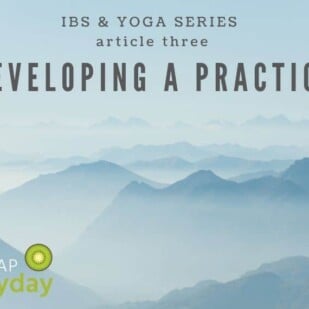This is the sixth article in the IBS & Yoga Series “It’s Your Body!” where we help you explore ways of learning to listen to your body. You can find the introduction here. And all of the articles here. And be sure to read our interview with Kiera.
Activating and Applying Your Self Knowledge
In this article, I’d like to feature a series of underlying principles of Traditional Chinese Medicine that encourage health related self empowerment.
I’ll operate under the assumption that you know more about yourself than anyone else knows about you. It sounds simple and obvious, but in many circumstances we hand over our healthcare to another person because they have years of medical training, and we assume and are taught they are the only people in our society truly equipped to make you well, or to “solve” your sickness. For some situations this might be true, but keep a discerning and open mind to when you actually might have more insight and understanding of your health than you think (or than a doctor possibly could).
Why You Know Yourself
Here are some reasons why. You have been present for your entire life. You have watched you grow and change. You feed yourself and choose your daily activities. You choose, develop and maintain your relationships. You know your habits and your secrets and your family history.
In the West, when it comes to our health, we more often go with the premise that Doctor Knows Best. In certain circumstances this may be true, but when it comes to identifying habits and creating sustainable change in your diet or lifestyle to ease your discomfort, give yourself some credit.You are the expert on You (and if you aren’t – start there).
“In [Western medicine’s] eagerness to be to be objective scientifically, we have become insensitive to the subjective part of any sickness – the patient….[however in the Eastern traditions] they diagnose the phenomenon occurring in the patient rather than searching for a particular disease. In short, they treat the phenomenon, not the disease” (Masunaga 1977)
Studies show that sufferers of IBS respond to many Eastern health practices for exactly this reason – the philosophy and practices emphasize and rely on the individual’s own particular imbalance, situation, patterns and history, and use that body’s own healing power and motivation to move towards health as the basis for treatment.
Body Unity vs. Fragmentation
In a wonderful book called Zen Shiatsu, I came across a passage that immediately stood out to me as a principle of Traditional Chinese Medicine that could be useful to people suffering from the chronic and often inexplicable states of discomfort and pain associated with IBS.
“When we are completely healthy, we feel oneness with our bodies. On the contrary, when we are unhealthy, stomach, head, [etc.] are separated and are felt as foreign. If you take care of your stomach [for example], it can be you. But when you ignore it, the stomach will insist on its existence.” (Masunaga 1977)
In other words, when healthy if you sit down and do a quick body scan (see end of post for suggestions on this), there won’t be a body part that stands out – you might not really be able to say that you feel much of anything. Your body will feel like one entity, one whole body and you will not be called to say “my back,” “my knee.”
However, when in imbalance or sickness, the affected area(s) will stand out to you and will be easy to identify. You could probably point to one or name it. It is then separate from the rest of your body, and from you, and your body no longer feels whole.
This principle gives us an action item which will lead us into another important principle and more action items! Our action item here is to learn how to do a body scan to begin to identify the pieces of ourselves that are not integrated into ourselves and that prevent us from achieving unity in and with our bodies. It will also serve you to gain confidence that your experience of your own body is accurate and helpful information.
Give yourself the job of taking stock of your body as you might the refrigerator. It doesn’t need to take long, and can be performed once every few days or, to get a really good sense of your body, after meals, upon waking and before going to sleep.
How to perform a body scan:
-
Stand in a comfortable position with your feet hips width below you, knees unlocked or slightly bent.
-
Close your eyes.
-
Take 3 slow, deep breaths to ground and settle yourself. Let your thoughts settle or observe them pass by.
-
Now start at your toes. Can you feel them? Wiggle them, and then keep them still. Send your next two breaths into your feet**. (**Sending breath to different body parts takes practice, just start by intending them to go there, after a good bit of practice, you will actually feel the oxygen flooding the intended area.)
-
Repeat Step 4 moving up your body: Knees, Hips, Lower Belly, Upper Belly, Chest, Throat, Arms, Face, Head and Mind.
-
Acknowledge where there is sensation (we will get into kinds of sensation later, for now just see which parts of your body stand out from the whole.) When scanning your mind, look for quality and pace of thought. Are you ruminating? Are you angry? Are you quiet?
-
If it helps you to remember or keep track over time, write it down. Sometimes I will just write down numbers 0 and 1 for each section – 0 if the body part does not speak to me, 1 if it does. TIP: Writing this down in a vertical line will also give you the shape of your current state, which will be useful for the next section of this series.
-
Let go of your findings, forgive yourself for having pain, give yourself some love and move on.
Pain As Stagnation
IBS may apply to many variations of stress or malfunctioning in the gut, and sufferers of IBS are not strangers to pain and discomfort. From an Eastern perspective, often what we feel as pain is understood as stagnation of qi or life energy. As the previous post investigated, pain makes us aware of a body part because it is alerting us to a deviation from healthy or balanced state.
When qi (or prana, life force etc.) is flowing and we are balanced, the body functions as one unit, a whole and integrated system. When we are sick or imbalanced, we are broken into parts and so it becomes easy to dissociate from pieces of ourselves and identify them as separate. Seeing pain as stagnation takes us one step further into understanding why and where our body is out of balance.
The Traffic Jam In Your Body
Imagine the life energy in your body flowing like a highway of cars. Imagine a highway with many cars driving in the same direction, and you are in one of them. You are going along smoothly, it’s a nice day, everyone is driving the speed limit, and you hardly notice that you are driving, you are thinking, talking on the phone, singing – whatever it is, you aren’t really focused on the driving.
Then, there is a slowdown and you come to a slow, annoying halt. You don’t know what has happened or why, but you may start to feel agitated and impatient. Now, you are thinking perhaps exclusively about the fact that you are driving, and so is everyone else in front of and behind you.
If you took a poll of how people were feeling before and during the traffic jam, you’d likely see a rise in anger, frustration, irritation, etc. Everyone in the traffic jam is now aware of driving because we have deviated from a state of normal flow – the people in the cars are uncomfortable, suffering, stuck – they are aware of themselves, the traffic has stagnated. The longer the traffic lasts, the more agitated the people in the cars will become.
If it is an accident, this could be a one time event and quickly cleared, it might not have a lasting impact on your mood or day. However say there is a new bridge being built, and every day for five years, there is the same back up. The people who have to take this route every day will likely have a more permanently affected mood or elevated stress levels that they may not even be aware of.
It’s helpful to look at pain in your own body as stagnation and deviation because it allows you to troubleshoot, and to bring attention to the area with curiosity and agency instead of fear and confusion in order that you may bring it back into the healthy place of oneness and flow.
Yoga and other mindful body practices are helpful for several reasons.
- Like routine roadwork, they physically help keep the flow moving steadily by pushing along minor stagnations through active work like breathing and stretching.
- They increase your understanding and awareness of what is your normal healthy state and how your body works & changes each day by giving you a few minutes of observation and charting it over time.
- They actually calm your body’s stress response, so that when it is in a state of pain (or when you are actually in a traffic jam!) there is a greater ability to see that this will pass, if there is or isn’t something to be done, and that the emotional responses of anger and irritation at the problem will only give you greater suffering.This understanding also helps show that pain is not usually random or inexplicable – there is generally an epicenter of deviation or stagnation that is blocking something from flow – and the close body listening taught by these body practices will help you tune in to where, specifically, that might be.
A Basic Sequence for getting some movement in the gut (like some daily roadwork).
Each of these can be done one at a time or in a sequence once you learn the basic moves. The videos chosen are for beginners – and offer modifications depending on your flexibility and any other limitations to movement. If you want to try another teacher’s version just search for the movements on YouTube. Or better yet, find a yoga class near you!
And as always…. we are NOT advocating any medical advice and if you have any concerns about moving your body in the manner shown in the videos please refrain until you are working with a professional yoga instructor.












